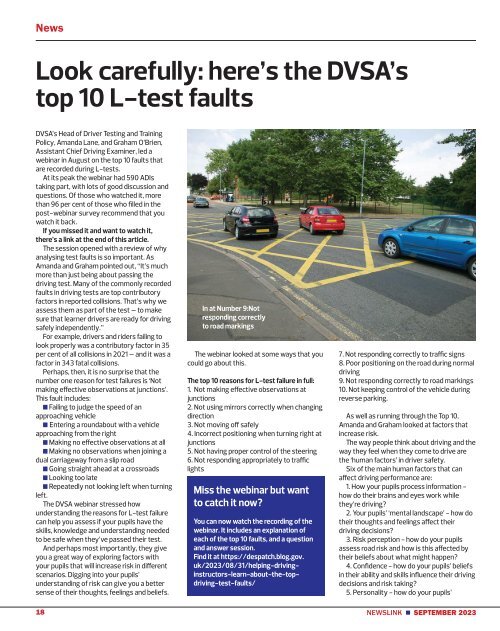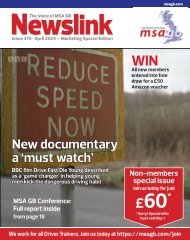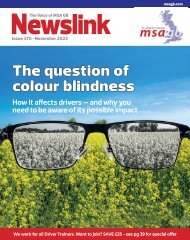Newslink September 2023
Motor Schools Association - driver training and testing - road safety
Motor Schools Association - driver training and testing - road safety
Create successful ePaper yourself
Turn your PDF publications into a flip-book with our unique Google optimized e-Paper software.
News<br />
Look carefully: here’s the DVSA’s<br />
top 10 L-test faults<br />
DVSA’s Head of Driver Testing and Training<br />
Policy, Amanda Lane, and Graham O’Brien,<br />
Assistant Chief Driving Examiner, led a<br />
webinar in August on the top 10 faults that<br />
are recorded during L-tests.<br />
At its peak the webinar had 590 ADIs<br />
taking part, with lots of good discussion and<br />
questions. Of those who watched it, more<br />
than 96 per cent of those who filled in the<br />
post-webinar survey recommend that you<br />
watch it back.<br />
If you missed it and want to watch it,<br />
there’s a link at the end of this article.<br />
The session opened with a review of why<br />
analysing test faults is so important. As<br />
Amanda and Graham pointed out, “It’s much<br />
more than just being about passing the<br />
driving test. Many of the commonly recorded<br />
faults in driving tests are top contributory<br />
factors in reported collisions. That’s why we<br />
assess them as part of the test – to make<br />
sure that learner drivers are ready for driving<br />
safely independently.”<br />
For example, drivers and riders failing to<br />
look properly was a contributory factor in 35<br />
per cent of all collisions in 2021 – and it was a<br />
factor in 343 fatal collisions.<br />
Perhaps, then, it is no surprise that the<br />
number one reason for test failures is ‘Not<br />
making effective observations at junctions’.<br />
This fault includes:<br />
n Failing to judge the speed of an<br />
approaching vehicle<br />
n Entering a roundabout with a vehicle<br />
approaching from the right<br />
n Making no effective observations at all<br />
n Making no observations when joining a<br />
dual carriageway from a slip road<br />
n Going straight ahead at a crossroads<br />
n Looking too late<br />
n Repeatedly not looking left when turning<br />
left.<br />
The DVSA webinar stressed how<br />
understanding the reasons for L-test failure<br />
can help you assess if your pupils have the<br />
skills, knowledge and understanding needed<br />
to be safe when they’ve passed their test.<br />
And perhaps most importantly, they give<br />
you a great way of exploring factors with<br />
your pupils that will increase risk in different<br />
scenarios. Digging into your pupils’<br />
understanding of risk can give you a better<br />
sense of their thoughts, feelings and beliefs.<br />
In at Number 9:Not<br />
responding correctly<br />
to road markings<br />
The webinar looked at some ways that you<br />
could go about this.<br />
The top 10 reasons for L-test failure in full:<br />
1. Not making effective observations at<br />
junctions<br />
2. Not using mirrors correctly when changing<br />
direction<br />
3. Not moving off safely<br />
4. Incorrect positioning when turning right at<br />
junctions<br />
5. Not having proper control of the steering<br />
6. Not responding appropriately to traffic<br />
lights<br />
Miss the webinar but want<br />
to catch it now?<br />
You can now watch the recording of the<br />
webinar. It includes an explanation of<br />
each of the top 10 faults, and a question<br />
and answer session.<br />
Find it at https://despatch.blog.gov.<br />
uk/<strong>2023</strong>/08/31/helping-drivinginstructors-learn-about-the-topdriving-test-faults/<br />
7. Not responding correctly to traffic signs<br />
8. Poor positioning on the road during normal<br />
driving<br />
9. Not responding correctly to road markings<br />
10. Not keeping control of the vehicle during<br />
reverse parking.<br />
As well as running through the Top 10,<br />
Amanda and Graham looked at factors that<br />
increase risk.<br />
The way people think about driving and the<br />
way they feel when they come to drive are<br />
the ‘human factors’ in driver safety.<br />
Six of the main human factors that can<br />
affect driving performance are:<br />
1. How your pupils process information -<br />
how do their brains and eyes work while<br />
they’re driving?<br />
2. Your pupils’ ‘mental landscape’ - how do<br />
their thoughts and feelings affect their<br />
driving decisions?<br />
3. Risk perception - how do your pupils<br />
assess road risk and how is this affected by<br />
their beliefs about what might happen?<br />
4. Confidence - how do your pupils’ beliefs<br />
in their ability and skills influence their driving<br />
decisions and risk taking?<br />
5. Personality - how do your pupils’<br />
18 NEWSLINK n SEPTEMBER <strong>2023</strong>

















